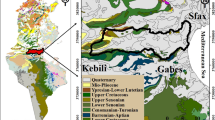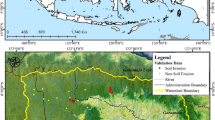Abstract
Water erosion of soils is increased by global warming and has a detrimental effect on natural resources. The situation is worse in the High Atlas, where a combination of natural and human forces accelerate erosion and reduce the income of local families. In this work, we assessed the existing erosion of the Haouz plain and projected water erosion of the soils into the future. The survey was conducted in three stages. In the first step, we estimated the annual erosion rate of the Haouz plain from 1992 to 2020 using the Revised Universal Soil Equation (RUSLE), publicly available data and the most recent land observations. The efficiency of the multi-criteria analysis method, taking into account how the second step’s water erosion is affected by the five RUSLE equation parameters. Analytical Hierarchy Process (AHP) was used to determine a weight for each criterion. Using new erosion parameters and the projected erosivity of precipitation from the sixteenth phase of the Coupled Model Intercomparison Project (CMIP6) models, the third stage involved predicting soil water erosion in 2040.
According to the results, the average annual soil erosion rate of the Haouz plain is currently 3.53 t ha-1 y-1. According to our predictions, the Haouz Plain will experience an increase in erosion to 4.41 t ha-1 y-1 and 5.31 t ha-1y-1 by 2040, respectively, under the circumstances indicated by RCP2.6 and RCP8.5. Policy makers seeking to adopt environmentally sound measures to halt the depletion of soil and water resources in semi-arid environments could use the current assessment and future predictions of soil water erosion in the Haouz Plain as a basis for data.
Graphical abstract

Highlights
A map** of the current soil water erosion risk in the Haouz plain was predicted.
The effects of climate change were integrated into the prediction of the R factor in 2040.
Water erosion in 2040 could potentially increase from current rates with rates ranging from 24.90 to 50.40%.








Similar content being viewed by others
References
Bagarello V, Stefano C, Di, Ferro V, Pampalone V (2017) Catena Predicting maximum annual values of event soil loss by USLE-type models. CATENA 155:10–19. https://doi.org/10.1016/j.catena.2017.03.002
Benavidez R, Jackson B, Maxwell D, Norton K (2018) A review of the (revised) Universal Soil loss equation ((R) USLE): with a view to increasing its global applicability and improving soil loss estimates. Hydrol Earth Syst Sci 22(11):6059–6086. https://doi.org/10.5194/hess-22-6059-2018
Benzougagh, B., Meshram, S. G., Abdallah, D., Larbi, B., Drisss, S., Khalid, M., & Khedher, K. M. (2020).Map** of soil sensitivity to water erosion by RUSLE model: case of the Inaouene watershed (NortheastMorocco). Arabian Journal of Geosciences, 13, 1–15. https://doi.org/10.1007/s12517-020-06079-y
Benzougagh B, Meshram SG, Dridri A, Boudad L, Baamar B, Sadkaoui D, Khedher KM (2022) Identification of critical watershed at risk of soil erosion using morphometric and geographic information system analysis. Appl Water Sci 12:1–20. https://doi.org/10.1007/s13201-021-01532-z
Benzougagh, B., Meshram, S. G., Fellah, B. E., Mastere, M., El Basri, M., Ouchen, I., ... & Turyasingura, B.(2023). Map** of land degradation using spectral angle mapper approach (SAM): the case of Inaouenewatershed (Northeast Morocco). Modeling Earth Systems and Environment, 1–11. https://doi.org/10.1007/s40808-023-01711-8
Bewket, W., & Teferi, E. (2009). Assessment of soil erosion hazard and prioritization for treatment at the watershed level: case study in the Chemoga watershed, Blue Nile basin, Ethiopia. Land degradation & development, 20(6),609–622. https://doi.org/10.1002/ldr.944
Brahim B, Meshram SG, Abdallah D, Larbi B, Drisss S, Khalid M, Khedher KM (2020) Map** of soil sensitivity to water erosion by RUSLE model: case of the Inaouene watershed (Northeast Morocco). Arab J Geosci 13:1–15. https://doi.org/10.1007/s12517-020-06079-y
Chadli K (2016) Estimation of soil loss using RUSLE model for Sebou watershed (Morocco). Model Earth Syst Environ 2:1–10. https://doi.org/10.1007/s40808-016-0105-y
Chandramohan T, Venkatesh B, Balchand AN (2015) Evaluation of three soil Erosion models for small watersheds. Aquat Procedia 4(Icwrcoe):1227–1234. https://doi.org/10.1016/j.aqpro.2015.02.156
Cristóbal JRS (2011) Multi-criteria decision-making in the selection of a renewable energy project in spain: the Vikor method. Renewable Energy 36(2):498–502. https://doi.org/10.1016/j.renene.2010.07.031
Dietz T, Millar D, Dittoh S, Obeng F, Ofori-Sarpong E (2004) Climate and livelihood change in North East Ghana. The Impact of Climate Change on Drylands January 2004https://doi.org/10.1007/1-4020-2158-5
El Jazouli A, Barakat A, Ghafiri A, El Moutaki S, Ettaqy A, Khellouk R (2017) Soil erosion modeled with USLE, GIS, and remote sensing: a case study of Ikkour watershed in Middle Atlas (Morocco). Geoscience Lett 4(1):1–12
El Jazouli A, Barakat A, Khellouk R, Rais J, Baghdadi E, M (2019) Remote sensing and GIS techniques for prediction of land use land cover change effects on soil erosion in the high basin of the Oum Er Rbia River (Morocco). Remote Sens Applications: Soc Environ 13:361–374. https://doi.org/10.1016/j.rsase.2018.12.004
Elaloui A, Marrakchi C, Fekri A, Maimouni S, Aradi M (2015) Mise en place d’un modèle qualitatif pour la cartographie des zones à risque d’érosion hydrique dans la chaîne atlasique: Cas du bassin versant de la Tessaoute amont. (Haut Atlas Central, Maroc). European Scientific Journal, 11(29)
Ganasri, B. P., Ramesh, H. (2016). Assessment of soil erosion by RUSLE model using remote sensing and GISA case study of Nethravathi Basin. Geoscience Frontiers, 7(6), 953–961. https://doi.org/10.1016/j.gsf.2015.10.007
Gourfi A, Daoudi L, Shi Z (2018) The assessment of soil erosion risk, sediment yield and their controlling factors on a large scale: Example of Morocco. J Afr Earth Sc 147:281–299. https://doi.org/10.1016/j.jafrearsci.2018.06.028
Gul M, Celik E, Gumus AT, Guneri AF (2017) A fuzzy logic based promethee method for material selection problems. Beni-Suef Univ J Basic Appl Sci. https://doi.org/10.1016/j.bjbas.2017.07.002
Haidara I, Tahri M, Maanan M, Hakdaoui M (2019) Efficiency of fuzzy Analytic Hierarchy process to detect soil erosion vulnerability. Geoderma 354:113853. https://doi.org/10.1016/j.geoderma.2019.07.011
Hurni, H. (1985). An ecosystem approach to soil conservation. Soil erosion and conservation, 73, 759–771.
Issa LK, Lech-Hab KBH, Raissouni A, Arrim E, A (2016) Cartographie quantitative du risque d’erosion des sols par approche SIG/USLE au niveau du bassin versant Kalaya (Maroc Nord Occidental). J Mater Environ Sci 7(8):2778–2795
Jaiswal RK, Ghosh NC, Galkate RV, Thomas T (2015) Multi criteria decision analysis (MCDA) for watershed. Aquat Procedia 4(Icwrcoe):1553–1560. https://doi.org/10.1016/j.aqpro.2015.02.201
Markhi, A., Laftouhi, N. E., Soulaimani, A., & Fniguire, F. (2015). Quantification et evaluation de l’1erosion hydriqueen utilisant le modèle RUSLE et d?positions int?gr?es dans un SIG. Application dans le bassin versant N'fis dansle haut atlas de Marrakech (Maroc). European Scientific Journal, 11(29).
Markhi A, Laftouhi N, Grusson Y, Soulaimani A (2019) Assessment of potential soil erosion and sediment yield in the semi-arid N′ fis basin (high Atlas, Morocco) using the SWAT model. Acta Geophys 67:263–272. https://doi.org/10.1007/s11600-019-00251-z
Meliho M, Khattabi A, Mhammdi N, Hongming Z (2016) Cartographie Des Risques De L’erosion Hydrique Par L’equation Universelle Revisee Des Pertes En Sols, La Teledetection Et Les Sig Dans Le Bassin Versant De L’ourika (Haut Atlas, Morocco). Eur Scientifc J November 2016 edition(vol12):227–297. https://doi.org/10.19044/esj.2016.v12n32p277
Meliho, M., Khattabi, A., & Mhammdi, N. (2020). Spatial assessment of soil erosion risk by integrating remotesensing and GIS techniques: a case of Tensift watershed in Morocco. Environmental Earth Sciences, 79, 1–19.https://doi.org/10.1007/s12665-020-08955-y
Mengistu D, Bewket W, Lal R (2015) Soil erosion hazard under the current and potential climate change induced loss of soil organic matter in the upper Blue Nile (Abay) River Basin, Ethiopia ReaearchGate. 137–163. https://doi.org/10.1007/978-3-319-09360-4_7
Meshesha, D. T., Tsunekawa, A., & Tsubo, M. (2012). Continuing land degradation: cause?effect in Ethiopia’s Central Rift Valley. Land degradation & development, 23(2), 13–143. https://doi.org/10.1002/ldr.1061
Moore ID, Burch GJ (1986) Physical basis of the length-slope factor in the universal soil loss equation Soil. Sci Soc Am J 50(5):1294–1298. https://doi.org/10.2136/sssaj1986.03615995005000050042x
Pan J, Wen Y (2014) Estimation of soil erosion using RUSLE in Caijiamiao watershed, China. Nat Hazards 71:2187–2205. https://doi.org/10.1007/s11069-013-1006-2
Panagos P, Borrelli P, Meusburger K (2015) A new European slope length and steepness factor (LS-Factor) for modeling soil erosion by water. Geosciences, 5 (2) (2015), pp. 117–126 https://doi.org/10.3390/geosciences5020117
Pimentel D (2006) Soil erosion: a food and environmental threat. Environ Dev 610 Sustain 8(1):119–137. https://doi.org/10.1007/s10668-005-1262-8
Piqué A, Soulaimani A, Hoepffner C (2007) Géologie du Maroc, Geode. Imprimerie El Watanya, Marrakesh, Morocco
Rahman MR, Shi ZH, Chongfa C (2009) Soil erosion hazard evaluation—An integrated use of remote sensing, GIS and statistical approaches with biophysical parameters towards management strategies. Ecol Model 220(13–14):1724–1734. https://doi.org/10.1016/j.ecolmodel.2009.04.0
Rango A, Arnoldus HMJ (1987) Aménagement des bassins versants. In: Cahiers techniques de la FAO: 1–11
Renard KG, Foster GR, Weesies GA, McCool DK, Yoder DC (1997) Predicting soil erosion by water: a guide to conservation planning with the revised universal soil loss equation (RUSLE). Agriculture Handbook No. 703. USAD-ARS, Washington
Saaty TL (1980) The analytic hierarchy process (AHP). J Oper Res Soc 41(11):1073–1076
Saaty TL, Vargas LG (1991) Prediction, projection and forecasting: applications of the analytic hierarchy process in economics, finance, politics, games and sports. Springer
Sadiki A, Bouhlassa S, Auajjar J et al (2004) Utilisation d’un SIG pour l’évaluation et la cartographie des risques d’érosion par l’Equation universelle des pertes en sol dans le Rif oriental (Maroc): Cas du bassin versant de l’oued Boussouab, vol 26. Bulletin de l’Institut Scientifique, Rabat, section Sciences de la Terre, pp 69–79
Sadiki A, Faleh A, Zêzere JL, Mastass H (2009) Quantification de l’Erosion en nappes dans le Bassin Versant de l’Oued Sahla-Rif Central Maroc. Cahiers géographiques 6:59–70
Seutloali KE, Beckedahl HR (2015) Understanding the factors influencing rill erosion on roadcuts in the south eastern region of South Africa. Solid Earth 6(2):633–641. https://doi.org/10.5194/se-6-633-2015
Sharpley AN, Williams JR (1990) EPIC – EPIC–Erosion/Productivity Impact Calculator: 1. Model documentation. USDA Technical Bulletin No. 1768, Washington, DC
Sheridan GJ, Noske PJ, Lane PN, Sherwin CB (2008) Using rainfall simulation and site measurements to predict annual interrill erodibility and phosphorus generation rates from unsealed forest roads: validation against in-situ erosion measurements. CATENA 73(1):49–62. https://doi.org/10.1016/j.catena.2007.08.006
Simonneaux V, Cheggour A, Deschamps C, Mouillot F, Cerdan O, Le Y (2015) Land use and climate change effects on soil erosion in a semi-arid mountainous watershed (high Atlas, Morocco). J Arid Environ 122:64–75. https://doi.org/10.1016/j.jaridenv.2015.06.002
Tahiri M, Achab M, Emran A et al (2014a) Lithology Data Contribution in Hydrographic Network distribution using remote sensing and GIS: case of the Tahaddart Basin, Northwestern Rif, Morocco. Int J Adv Res 2:380–391
Tahiri M, Tabyaoui H, El Hammichi F, Achab M, Tahiri A, Hadi E, H (2017) Quantification de l’érosion hydrique et de la sédimentation à partir de modèles empiriques dans le bassin versant de tahaddart (Rif nord occidental, Maroc), vol 39. Bulletin de l’Institut Scientifique, Rabat, Section Sciences de la Terre, pp 87–101
Van Zijl G (2019) Digital soil map** approaches to address real world problems in southern 650 Africa. Geoderma 337:1301–1308. https://doi.org/10.1016/j.geoderma.2018.07.052
Vulević T, Dragović N (2017) Multi-criteria decision analysis for sub-watersheds ranking via the PROMETHEE method. Int Soil Water Conserv Res 5(1):50–55. https://doi.org/10.1016/j.iswcr.2017.01.003
Williams, J. D., Wilkins, D. E., Douglas Jr, C. L., & Rickman, R. W. (2000). Mow-plow crop residue managementinfluence on soil erosion in north-central Oregon. Soil and Tillage Research, 55(1–2), 7–78.https://doi.org/10.1016/S0167-1987(00)00100-8
Wischmeier WH, Smith DD (1978) Predicting rainfall erosion losses: a guide to conservation planning. Department of Agriculture, Science and Education Administration
Yjjou M, Bouabid R, El Hmaidi A, Essahlaoui A, Abassi E, M (2014) Modélisation de l’érosion hydrique via les SIG et l’équation universelle des pertes en sol au niveau du bassin versant de l’Oum Er-Rbia. Int J Eng Sci (IJES) 3(8):83–91
Author information
Authors and Affiliations
Corresponding author
Additional information
Publisher’s Note
Springer Nature remains neutral with regard to jurisdictional claims in published maps and institutional affiliations.
Rights and permissions
Springer Nature or its licensor (e.g. a society or other partner) holds exclusive rights to this article under a publishing agreement with the author(s) or other rightsholder(s); author self-archiving of the accepted manuscript version of this article is solely governed by the terms of such publishing agreement and applicable law.
About this article
Cite this article
Bammou, Y., Benzougagh, B., Bensaid, A. et al. Map** of current and future soil erosion risk in a semi-arid context (haouz plain - Marrakech) based on CMIP6 climate models, the analytical hierarchy process (AHP) and RUSLE. Model. Earth Syst. Environ. 10, 1501–1514 (2024). https://doi.org/10.1007/s40808-023-01845-9
Received:
Accepted:
Published:
Issue Date:
DOI: https://doi.org/10.1007/s40808-023-01845-9




